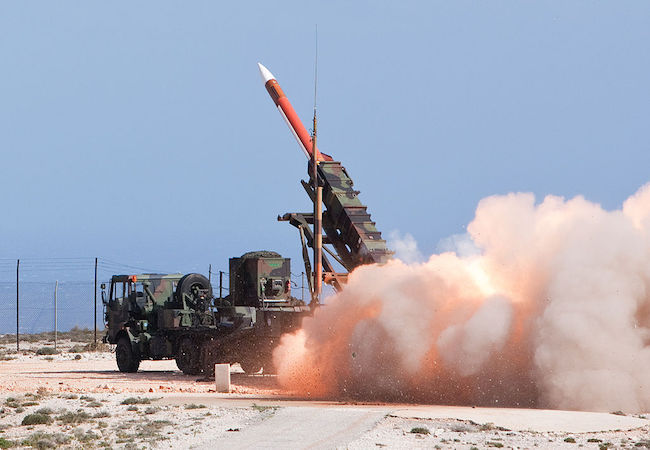
By Debalina Ghoshal
In November 2015, reports came in that the Netherlands, a NATO country, has decided to upgrade its existing Patriot batteries to strengthen its air defence capabilities between 2017 and 2021. The Netherlands chose to stick to its Patriot systems instead of buying the Lockheed Martin’s Medium Extended Air Defence Systems (MEADS). This is not the first time that a NATO country has rejected MEADS and, instead, chosen to upgrade their Patriot systems. Poland also chose to upgrade its Patriot systems instead of buying the MEADS to strengthen their air defence capabilities despite the 360 degree coverage that MEADS system are reported to provide, which is essential for air and missile defence.
Why Patriot?
There are several reasons for the Netherlands to opt for upgrading its Patriot systems rather than buying the new MEADS, despite the fact that MEADS offers 360 degree coverage. One reason is that upgrading the Patriot system to the PAC-3 is a more affordable option for the Netherlands than to buy an expensive new program like MEADS.
The Netherlands has been operating the Patriot batteries since 1987. The Netherlands also deployed Patriot batteries in Israel during the 1991 Gulf War to protect Israel against Iraqi Scud missiles. In 2007, the Netherlands became the first international customer to buy the PAC-3 system and 32 of them were delivered by Lockheed Martin to the Royal Netherlands Air Force.
A second reason the Netherlands would upgrade its current systems is that the US and most NATO countries operate the Patriot systems and, hence, interoperability is easier. With interoperations between other NATO countries possessing Patriot systems, the Netherlands has been able to develop command and control systems and “system of systems” for NATO. The Defence Ground-based Air and Missile Defence Command operates the Patriot Air Defence Systems and it also operates the Norwegian Advanced Surface to Air Missiles, Fennek Stinger Weapon Platform and the air space monitoring radar.
It is a known fact that the Netherlands not only hosts such batteries in its own country, but also has hosted such Patriot batteries post Syrian crisis in Turkey until early this year. When it decided to withdraw from Turkey early in 2015, Spain agreed to replace them and, thereafter, their operation has been a smooth process because of the “standardised” work process.
The third reason why it is wise that the Netherlands not switch to MEADS is that the Patriots are already battle tested and operational. Fourth, the Dutch have also reasoned out their decision to stick to the Patriot system on grounds that the MEADS has not been completed yet and, hence, it is uncertain.
Present Capabilities
The Royal Netherlands Navy, on the other hand, possesses the Air Defence Command Frigates, while the Army possesses the Army Ground Based Air Defence System (AGBADS). The PAC-3 forms a crucial component of the Integrated Air and Missile Defence (IAMD) system, which forms an integral part of the Netherlands Armed Forces. From 2018, the Navy plans to have four frigates with early warning capabilities for detecting and tracking incoming ballistic missiles.
It is well understood that the Netherlands has played an integral role in the NATO missile defence shield throughout its development process. In 2012, according to reports, the Netherlands’ role in strengthening the NATO missile defence system was to upgrade four air-defence frigates with extended long range “Smart-L” radar systems. These radar systems can detect and track incoming ballistic missiles at a distance of more than 1000km and then transfer the information to NATO missile defence, which could then conduct interception. This radar is reported to be capable of detecting stealth targets at medium range and is also equipped with Electronic Counter Counter Measures (ECCMs). NATO technicians have also conducted series of tests linking weapons and sensor systems of France, Germany, Italy, Netherlands and the U.S. as a component of the Active Layered Theatre Ballistic Missile Defence (ALTBMD) System.
Reports also suggest that there is a possibility to integrate the SM-3 interceptors with Dutch BMD capability. In October 2015, an ‘At Sea Demo’ (ASD) was conducted in which, for the first time, the SM-3 missile was fired from the Arleigh Burke class guided missile destroyer USS Ross. Several European countries seeking to develop a robust sea-based missile defence capability joined the ASD, amongst which was the Netherlands. The Netherlands’ Royal Navy’s De Zeven Provinciën-class frigates are also capable of firing SM-2 interceptor missiles. Reports suggest that these frigates would receive radar and combat system upgrade that would enable them to contribute to NATO BMD initiative.
Conclusion
With the growing American influence in Asia Pacific periphery, NATO countries may need to cooperate amongst themselves to develop a robust missile defence system. No doubt, the Netherlands plays a crucial role in the NATO BMD system.




